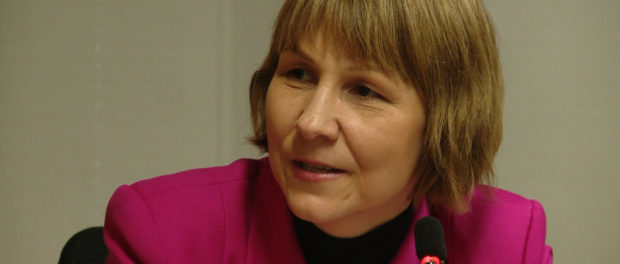The Slow Wheels of Justice in We Can’t Make the Same Mistake Twice
TV court dramas are deceiving. An hour for a whole case, from police investigation to final verdict. In real life, the wheels of justice turn at a much slower pace. Dr. Cindy Blackstock first brought a complaint against the Canadian Government (specifically the Indian Affairs and Northern Development Canada) in 2007 for discriminatory practices regarding the delivery of social services to children on reserves. The complaint was dismissed, but Dr. Blackstock along with a human rights organization called The Child and Family Caring Society and the Assembly of First Nations, pressed on until the historic reversal of the decision this year. Alanis Obomsawin’s film, We Can’t Make the Same Mistake Twice, follows Dr. Blackstock and her organization’s pursuit of justice, while Canada’s defense team uses surveillance, loopholes, delays, withholding of documents and legalese.
The film is long (2 h 43 minutes) and with its fly-on-the-wall approach of capturing actual testimony, it requires patience to watch. Law is tedious. No one pulls crazy courtroom stunts or throws furniture or gets held in contempt of court. The opposing sides both stand for the judges’ entries and exits and shake hands after every tribunal. We watch the fatigued faces of those who have spent the day listening in the courtroom. Piles of legal papers surround every table. Pivotal moments in the case are subtle. This is not an on the stand meltdown, but rather a stutter or a flailing about for the right words.
More to the point, the story is important — historically and socially. It is worth our complete attention, if only so we are aware of the disparities that exist in Canada and our ignorant compliance with an unacceptable status quo. We listen as Dr. Blackstock and others give patient but passionate depositions at the tribunals. We hear from those involved in delivering social services to children on reserves from many provinces and how they face funding friezes along with no consideration for meeting the basic operational needs of delivering those services. Fireproof locked cabinets, space to operate, and even transport are not funded. Interspersed are the stories of some of the individuals whose experiences relate to the case, including a Nova Scotia mother who is told that she must institutionalize her hydrocephalic boy when she recovers from a stroke.

We Can’t Make the Same Mistake Twice.
Obomsawin captures the minutiae of jurisprudence as well as pivotal moments in this many-year-long process. The initial dispute hinges on whether “discrimination” is happening. Social services are handled off-residence by the province, while those handled on reservations are handled by the federal government. The government’s lawyers argue that you can’t compare the delivery of services by two different providers. Dr. Blackstock and a team of lawyers manage to cross this first hurdle and it is game on.
One thing the film assumes is familiarity with the treaties with the First Nations, namely that the federal government of Canada agreed to provide health care and education to First Nations people. For the last hundred plus years in a combination of racism, economics, and ignorance, this policy has been one of assimilation and colonization. To receive the government supplied education and health, First Nations people away from their homes and communities. The residential schools are one such example — “civilizing” the Indians meant “killing the Indian in the child” — and the legacy of these brutal, places haunts every aspect of native lives and this court case as well. In perhaps the most moving segment of the film, we hear from Chief Joseph, a survivor as he recounts his story from a Pacific Northwest community to the St. Michael’s residential school in Alert Bay where he is stripped of his identity and dignity. Through Obomsawin’s lens, we see testimony from Chief Denise Stonefish that connects the dots; the inadequate delivery of social services to children is just one more manifestation of this persistent, historical maltreatment of Fist Nations.
We also see how the Canadian government pays lip service while using some rather loopholes to get out of its obligations. The film discusses Jordan’s Principle, created when Jordan River Anderson of Norway House First Nation was died in a Winnipeg hospital because the federal and provincial governments could not resolve who would pay for his home care. While Jordan’s Principle should in theory prevent such situations from arising again, one woman struggles to explain how the 11 million dollars given to the fund disappeared from lack of use. Apparently, the cases where the monies were needed failed to meet the four impossible criteria required to receive the funding.
Obomsawin’s great success in the film is not its dramatic narrative. It is that we witness a landmark decision and the work that went into making it happen, as well as the suffering of those who brought it to bear. Ever in the background are emblems of another significant issue — Shannen’s dream — the search for equality in education. This subtle, powerful film certainly leaves the viewer wondering what other unfairnesses happen but are unknown. What is shocking most of all is that the amount of money spent on the multi-year court case could probably have been better spent paying for the needs of the people in Canada’s care. Overall, the film serves as a historic document to highlight and humanize a significant legal moment in Canada’s history.
We Can’t Make the Same Mistake Twice showed at the RIDM, which continues until November 20. Tickets and schedules HERE.






